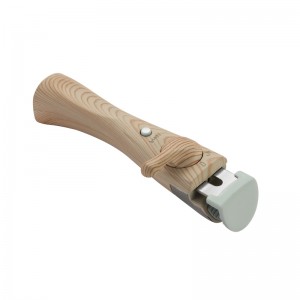Modern kitchens demand tools that blend safety, durability, and aesthetics. Silicone-Stainless Steel (SS) cookware handles perfectly embody this fusion, offering a superior solution to traditional all-metal or plastic handles. Let's explore their key characteristics, how they're made, and why they're indispensable.
Material: Silicone + SS 430
Length: 17cm/ 21cm
Dia of SS wire: 8mm/ 10mm
Screw hole: 5.1cm
Thickness of silicone: 11mm
Product Features: Where Safety Meets Strength
1. Heat Resistance & Safety in use: Food-grade silicone, inherently heat-resistant (typically up to 220°C/428°F or higher), forms the outer layer. This creates a reliably cool-to-touch grip, even when the pan or pot body is scorching hot. No more burnt fingers or cumbersome mitts.
2. Secure, Ergonomic Grip: Silicone's naturally soft, slightly tacky texture provides an exceptional non-slip grip, even with wet or greasy hands. Its flexibility allows for ergonomic shaping, enhancing comfort and control during cooking and pouring.
3. Robust Structural Core: Beneath the silicone lies a core of high-quality stainless steel ( 430 grade). This provides the essential structural strength and rigidity, ensuring the handle can securely bear the weight of a full pot or pan without bending, warping, or loosening.
4. Durability & Longevity: Stainless steel handles resists corrosion and withstands high oven temperatures. Silicone is highly resistant to cracking, fading, and degradation from oils or cleaning agents. Together, they create a handle built to last.
5. Easy Maintenance & Hygiene: Both silicone and stainless steel are non-porous, making them highly resistant to stains and odors. They are generally dishwasher-safe for effortless cleaning, promoting excellent kitchen hygiene.
6. Aesthetic Appeal: Available in a wide spectrum of vibrant colors, silicone adds a modern, stylish touch to cookware, complementing various kitchen decors.
Production Process: Bonding Strength and Comfort
Manufacturing Silicone-SS handles involves precision engineering:
- Stainless Steel Core Fabrication: The inner SS core is precisely cut, shaped (often via stamping or machining), and polished. Holes or features for attaching to the cookware body and bonding with silicone are incorporated.
- Surface Preparation: The bonding surfaces of the SS core undergo specialized treatment (like cleaning, etching, or priming) to ensure optimal adhesion with the silicone.
- Molding & Bonding: The prepared SS core is placed into a custom mold cavity. Liquid silicone rubber (LSR) is then injected under high pressure directly around the core (a process called overmolding or insert molding). The silicone flows into every detail, encapsulating the bonding areas.
- Curing: The mold is heated, causing the liquid silicone to vulcanize (cure) into a solid, elastic state. This curing process creates a strong, permanent chemical and mechanical bond between the silicone and the specially prepared SS surface.
- Demolding & Finishing: Once cured, the finished handle is removed from the mold. Any minor imperfections (like excess silicone "flash") are trimmed, and the handle undergoes final quality inspection.
Functional Benefits in Use: Performance You Can Feel
The hybrid design translates directly to superior user experience:
Safe Handling: The primary function: enabling safe lifting, moving, and pouring of hot cookware without burns. The silicone barrier effectively insulates heat from the metal core.
Silicone-SS cookware handles represent a significant advancement in kitchen ergonomics and safety. By seamlessly combining the cool, secure grip of food-grade silicone with the unwavering strength and durability of stainless steel, they offer unparalleled functionality and longevity. They are not merely handles; they are essential safety features that make cooking safer, easier, and more enjoyable. For manufacturers and consumers alike, they are the intelligent, modern solution for premium cookware.






